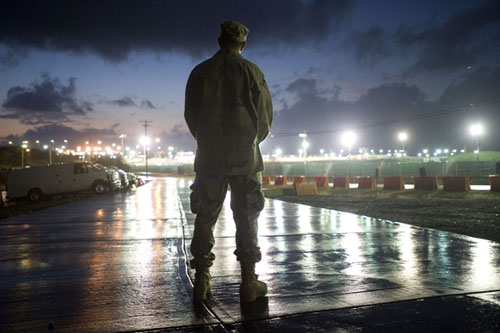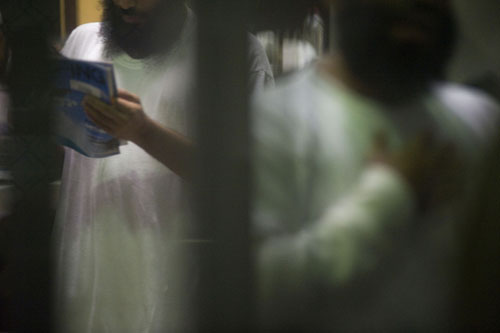
A military official standing outside Camp Delta in the early morning rain. (Louie Palu / ZUMA Press)
I have just completed my second and last OPSEC review of my photographs. It is apparent that perhaps a new regime is taking hold here and some of the restrictions placed on photography are being slowly loosened. Baby steps—but perhaps this is an early sign of change.
My day started out with a light rain on the way to Camp Delta, which houses the majority of the detainees. The clouds at sunrise inflated and bloomed out of the horizon like soft puffy mountains. When it rains here the humidity goes through the roof, and it seems to awaken the sand fleas’ voracious desire to bite. There was a flurry of activity at dawn as guards and military personnel arrived for their shift. As much as this place is shrouded in mystery for those who will never visit, watching this personnel in action I was struck by all the things I haven’t seen in my four visits here since 2007. I have never seen attack dogs—or dogs of any kind, for that matter. I have never seen any detainees hooded or blindfolded. Among the almost one hundred detainees I have seen, I have encountered only one in an orange jump suit; they almost all wear white or light colored loose fitting pants and shirts. The orange jumpsuits are reserved for detainees who are non-compliant, and after touring Camp 5 (where they’re usually kept) there don’t seem to be very many.

Detainees on a morning run in a recently contructed recreation yard in Camp 6. (Louie Palu / ZUMA Press)
Today, we started out at Camp 6 again, where detainees began their morning in a recently constructed outdoor yard topped by razor wire and encircled a second fence wrapped with translucent fabric—so one can see out of or into the yards. Some of the detainees ran laps around the yard; other just milled around or sat at picnic tables. Many have grown long bushy beards and some flowing hair. (One veteran journalist has nicknamed a particular detainee “Fabio,” as his hair is as long as the Harlequin cover model’s.)
As the morning dragged on, the sun continued to pound down. When we went back into the building at Camp 6, I was relieved to be back in the air conditioning. Here we were permitted to witness partial detainee movements from one area to another and the distribution of books and reading material. (One detainee was reading a magazine on surfing.) Then we saw food distribution and detainees socializing and taking a life skills class—which points to the possible direction for many of the inmates here: eventual transfer and release, if the administration can figure out that legal minefield.

A shackled detainee is moved by camp guards in Camp 6. (Louie Palu / ZUMA Press)

Detainees read through magazines and books that were distributed to them in Camp 6. (Louie Palu / ZUMA Press)
Having covered the war in southern Afghanistan over the past four years, I have come to understand (and at the same time be confused by) many of the people and issues that have originated from that tragic land. Guilty or not, nothing will come easy for the detainees here as they look for a way off this island, just as the Obama administration is struggling to find its way out of the wars that created this institution in the first place. As I watched the detainees pace the open yards in Camp 4 at the end of the day, I was reminded of many Afghans I have met in Kandahar. As I stood by the fence one detainee approached me and, communicating through a guard, said I could photograph him. He just asked that I not show his face—which, according to the rules, I couldn’t do anyway. I aimed my camera at his feet, but he requested that I not photograph his feet. He said they were dirty. Then he said no more pictures.







